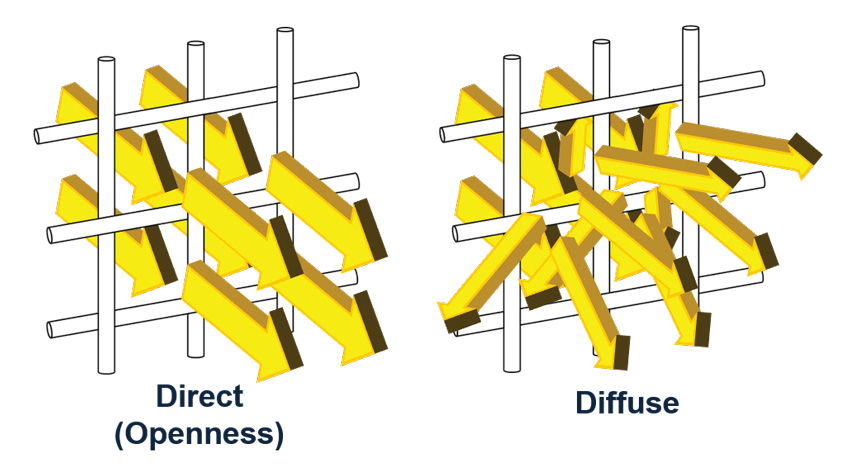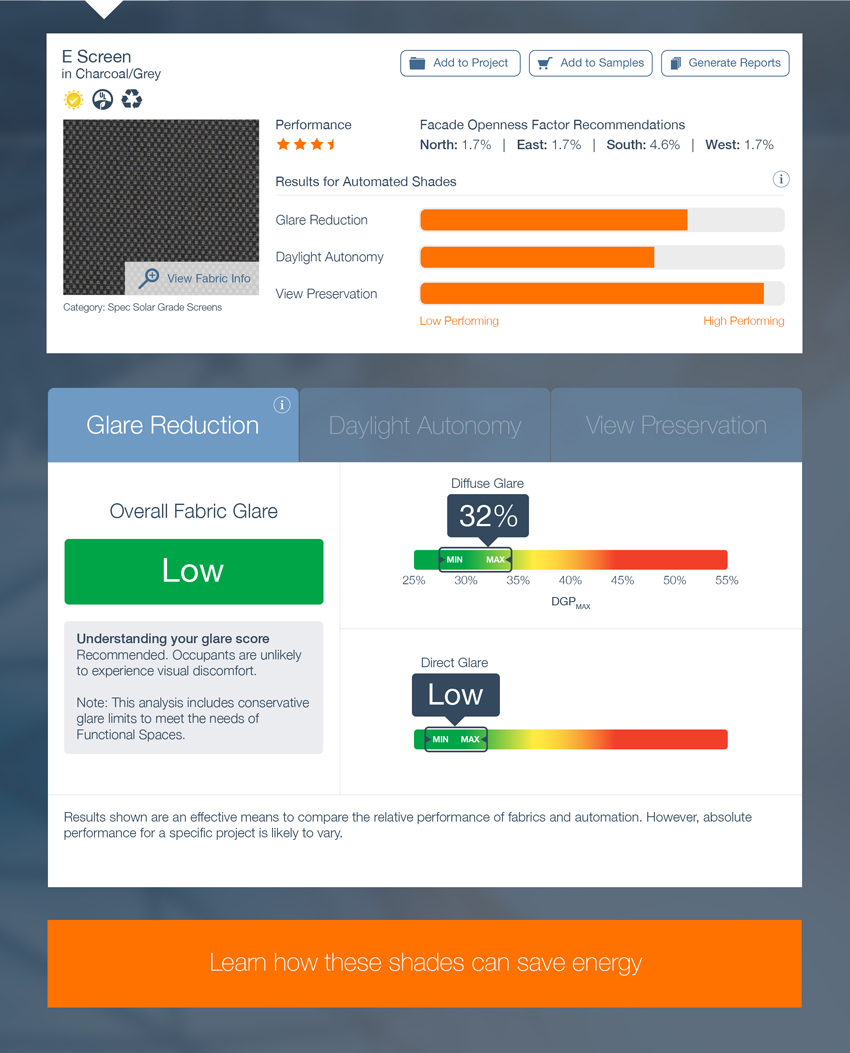Top Five Tips for Successful Daylighting Design
Tip #4: Consider More Than Color When Selecting a Solar Shade Fabric
As a fabric, the shade fabric is often selected during the furnishings and finishes stage of the job. Oftentimes a large fabric binder is placed in front of the design team, and the shade fabric is selected based on the color and style that best complements the interior décor. On some occasions, openness may be decided based on loose rules of thumb. Unfortunately, this aesthetics-based approach does not take into consideration the fabric’s ability to control glare, preserve view, allow diffuse daylight into the space, or mitigate solar heat gain. When color is the key consideration in selecting a fabric, specifiers are likely to get a product that looks good on the wall but may not provide satisfactory daylighting performance. Before specifying a fabric, be sure to match the fabric properties—openness factor, visible transmittance, solar reflectance, and color—to the daylighting management needs of the space.
Openness Factor
The openness factor (OF) of a shade fabric refers to the amount of light that is able to pass straight through the shade. If a shade has an openness factor of 5 percent, then 5 percent of the sunlight that transmits through the window at an angle that is perpendicular to the pane will pass directly through the shade and into the interior. The remaining 95 percent of the light that contacts the shade fabric will be diffused, reflected, or absorbed.
Visible Light Transmittance
Visible light transmittance (Tv) refers to the total amount of light allowed to move through the shade and into the space. It includes both direct and diffuse light energy in its calculation.

Image courtesy of Lutron Electronics
Visible light transmittance (Tv) refers to the total amount of direct and diffuse light allowed to move through the shade.
The Tv value of a shade is primarily affected by the physical openness in the weave and the color of the shade, but it is also influenced by the shape, opacity, and specific pattern of the weave. Dark fabrics absorb more of the available daylight than light-colored fabrics, ultimately affecting the amount of light available to pass through the shade. When openness factors are equal, a dark-colored fabric will often have a lower Tv value than a light-colored shade fabric. However, there can be significant performance differences between fabrics of the same color. Be sure to review the Tv value of a fabric when specifying solar shades to better understand how that product will perform in the space.
Solar Reflectance
Solar reflectance (Rs) refers to the percentage of the total solar radiation that is reflected off of the exterior face of the fabric and back outside. Solar reflectance values are determined, in large part, by the color or coatings on the exterior face of the fabric. Dark colors absorb more of the available light energy and, therefore, offer lower reflectance values. Lighter-colored fabrics reflect more of the light energy and provide higher solar reflectance values. For example, a standard black solar shade fabric will typically offer an Rs value in the neighborhood of less than 10 percent, where a white fabric can deliver Rs values of 50 percent. As a general rule, Rs values greater than 30 percent will provide some protection from solar heat gain, while an Rs value of 50 percent or greater provides good thermal protection. Remember that there are ways to have fabrics with a high reflectance exterior and dark interior color. This includes dual-sided fabrics, metal-backed fabrics, and fabrics with special coatings.
Color
Solar shade fabrics are available in a wide range of colors and styles: neutrals, bolds, and pastels with patterns, textures, or graphics. Designers can find a shade fabric that will complement any type of interior décor.
Matching Fabric Property and Performance
When attempting to identify which fabric properties will achieve the prioritized design objectives, it is important to acknowledge that the fabric properties are interrelated. Here is some guidance on how these different fabric properties work together to control glare, allow ambient daylight into the space, preserve outdoor views, and mitigate solar heat gain.

Image courtesy of Lutron Electronics
This table illustrates how daylighting objectives can conflict and underscores the importance of prioritizing project goals to select the right fabric.
There are web tools available that have been designed to consider conflicting daylighting objectives and identify suitable fabric options based on the various properties of the fabric and the desired performance specifications.

Image courtesy of Lutron Electronics
The Performance Shading Advisor (shown here) is an example of a web tool that can balance daylighting objectives and help designers select fabrics that will perform as needed.
Fabric Properties to Control Glare
Solar screen fabrics with different openness factors are often specified throughout a project to best match the need for direct sunlight control on each facade and elevation. East and west-facing facades, particularly with clear glass, that experience direct sun exposure during sunrise and sunset are often matched with solar shade fabrics that have an openness factor of 3 percent or less (recommended: 1 percent). The smaller openness factor creates a finer filter across the window pane and effectively diffuses even the orb of the sun when it is in view. Fabrics with openness factors of 4 percent or less (recommended: 2 percent) are typically placed on southern-facing windows that have a direct view of the sun. Windows with northern exposures are often outfitted in fabric shades with larger openness factors, allowing more of the readily available ambient light into the space.
A shade with a low Tv value will also provide good diffuse daylight control and limit the potential for the fabric to become overly bright when managing intense daylight conditions. Remember that white fabrics, even with low openness factors, become a very bright glare source when in contact with direct sunlight.
Fabric Properties to Maximize Daylighting
If the design objective is to maximize the amount of glare-free daylight that is allowed into a space in order to achieve the greatest degree of energy savings possible, then select a shade with the highest Tv value that still maintains glare control. The higher Tv value will increase the amount of light, both direct and diffuse, that is allowed through the shade fabric and into the space.
Fabric Properties for View Preservation
The crispness and clarity of view afforded through a shade fabric can be predicted as a function of the Tv value and openness factor. Darker fabrics with higher openness factors generally achieve a higher degree of clarity, followed by dark-colored fabrics with low openness factors. Light-colored fabrics typically provide the most interference with outdoor views, offering slightly muddied or muted versions of the surrounding colors.
Until recently, no metric that defined the clarity of view existed to help a design team specify a shade fabric on a project. The View Clarity Index (VCI) ranks view clarity from 0 to 100 percent. A value of 100 percent means that the fabric causes no perceivable interference with exterior views. At 50 percent, most of the objects on the exterior are recognizable, although the edges are blurred and colors visible, but washed out. A value of zero indicates that no view is visible through the fabric.
Fabric Properties for Thermal Management
Manufacturers have developed shades that improve thermal management without negatively impacting view preservation. Dual-sided fabrics were introduced to offer a significantly improved Rs value, often above 50 percent, which dramatically improves heat rejection of the fabric, without sacrificing the clarity of the objects or colors seen on the other side.

Photo courtesy of Lutron Electronics
Clearly identifying the daylight management needs of a project and then selecting interior solar shades with automated controls and a shading fabric with the right daylight properties equips every space for daylighting success.









